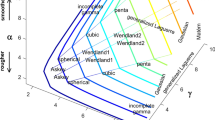Abstract
The differentiability of a random field has a direct relationship with the differentiability of its covariance function. We review the concept of differentiability of space–time covariance models and random fields, and its implications on predictions. We analyze the change of behavior of the covariance function at the origin and at different space–time lags away from the origin, by using the concept of smoothness which can be considered the geometrical view of the differentiability. We propose a way to measure the smoothness of any covariance function, and apply it to purely spatial and space–time covariance functions.








Similar content being viewed by others
References
Adler RJ (2009) The geometry of random fields. Siam, Philadelphia
Banerjee S, Gelfand A (2003) On smoothness properties of spatial processes. J Multivar Anal 84(1):85–100
Cressie N, Huang H (1999) Classes of nonseparable, spatio-temporal stationary covariance functions. J Am Stat Assoc 94(448):1330–1340
Cressie N, Wikle C (2011) Statistics for spatio-temporal data, vol 465. Wiley, New York
De Iaco S, Myers D, Posa D (2002) Nonseparable space–time covariance models: some parametric families. Math Geol 34(1):23–42
Diggle P, Ribeiro P (2007) Model-based geostatistics, vol 13. Springer, New York
Eriksson M, Siska P (2000) Understanding anisotropy computations. Math Geol 32(6):683–700
Fernández-Avilés G, Montero JM, Porcu E, Schlather M (2012) Space–time processes and geostatistics. Advances and challenges in space–time modelling of natural events. Springer, New York, pp 1–23
Gerharz LE, Pebesma E (2013) Using geostatistical simulation to disaggregate air quality model results for individual exposure estimation on gps tracks. Stoch Environ Res Risk Assess 27:223–234
Gneiting T (2002) Nonseparable, stationary covariance functions for space–time data. J Am Stat Assoc 97(458):590–600
Hristopulos DT, Elogne SN (2007) Analytic properties and covariance functions for a new class of generalized gibbs random fields. IEEE Trans Inf Theory 53(12):4667–4679
Hristopulos DT, Žukovič M (2011) Relationships between correlation lengths and integral scales for covariance models with more than two parameters. Stoch Environ Res Risk Assess 25(1):11–19
De Iaco S, Myers D, Posa D (2001) Space–time analysis using a general product–sum model. Stat Probab Lett 52(1)21–28
Kent J, Mohammadzadeh M, Mosammam A (2011) The dimple in gneiting’s spatial-temporal covariance model. Biometrika 98(2):489–494
Ma C (2008) Recent developments on the construction of spatio-temporal covariance models. Stoch Environ Res Risk Assess 22:39–47
Mateu J, Porcu E, Gregori P (2008) Recent advances to model anisotropic space–time data. Stat Methods Appl 17(2):209–223
Mateu J, Fernández-Avilés G, Montero J (2011) On a class of non-stationary, compactly supported spatial covariance functions. Stoch Environ Res Risk Assess 27(2):297–309
Mehlum E, Tarrou C (1998) Invariant smoothness measures for surfaces. Adv Comput Math 8(1):49–63
Porcu E, Gregori P, Mateu J (2006) Nonseparable stationary anisotropic space–time covariance functions. Stoch Environ Res Risk Assess 21(2):113–122
Porcu E, Mateu J, Zini A, Pini R (2007) Modelling spatio-temporal data: a new variogram and covariance structure proposal. Stat Prob Lett 77(1):83–89
Porcu E, Mateu J, Saura F (2008) New classes of covariance and spectral density functions for spatio-temporal modelling. Stoch Environ Res Risk Assess 22:65–79
Porcu E, Mateu J, Christakos G (2009) Quasi-arithmetic means of covariance functions with potential applications to space–time data. J Multivar Anal 100(8):1830–1844
Stein M (1999) Interpolation of spatial data: some theory for kriging. Springer, New York
Stein M (2005) Space–time covariance functions. J Am Stat Assoc 100(469):310–321
Stoker J (1969) Differential geometry. Wiley Interscience, New York
Xue Y, Xiao Y (2011) Fractal and smoothness properties of space–time Gaussian models. Front Math China 6(6):1217–1248
Acknowledgments
Work partially funded and supported by Grants MTM 2010-14961 and P1-1B2012-52.
Author information
Authors and Affiliations
Corresponding author
Rights and permissions
About this article
Cite this article
Bohorquez, M., Mateu, J. & Diaz, L. A note on smoothness measures for space–time surfaces. Stoch Environ Res Risk Assess 28, 1011–1022 (2014). https://doi.org/10.1007/s00477-013-0797-8
Published:
Issue Date:
DOI: https://doi.org/10.1007/s00477-013-0797-8




